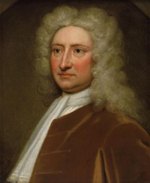Who was Halley?
"This sight... is by far the noblest astronomy affords"
Sir Edmond Halley (1656-1742) was an English astronomer who is best known for his study of comets. He was born in London and educated at Oxford.
Halley was intrigued by the theories of his contemporary Sir Isaac Newton and encouraged him to write the "Principia." When Newton finished this work in 1687, Halley paid out of his own pocket to have it published.
 Halley was made Astronomer Royal in 1721 and began an 18-year study on the phases of the moon.
Halley was made Astronomer Royal in 1721 and began an 18-year study on the phases of the moon.
Halley's most important scientific work was his "Synopsis on Cometary Astronomy" which he started in 1682 and finished 1705. In this work Halley applied Newton's Laws of Motion to all available data on comets. Through mathematical calculations, he discovered that one of the comets he observed in 1682 had the same orbit as one seen in 1607.
In a thrilling piece of detective work, he found that another comet observed in 1531 with the same orbit as well. Clearly, these three appearances were actually one comet that traveled in an elliptical orbit around the sun and appeared about every 76 years. In honor of this amazing discovery the comet was named Halley's Comet. Halley's theory was proved correct in 1758 when the comet was again visible from Earth, but unfortunately he did not live long enough to see it.
Timeline
- 684 The comet is seen in Europe.
- 1145 A monk drew a picture of the comet.
- 1531 An astrologer measured its movements in the sky.
- 1682 The comet was seen by Dr Halley. It was named Halley's Comet.
- 1758 Halley's Comet returned.
- 1872 The council changed VINCENT ST to HALLEY ST.
- 1910 Halley's Comet was photographed for the first time.
- 1989 The school was named after the street!










